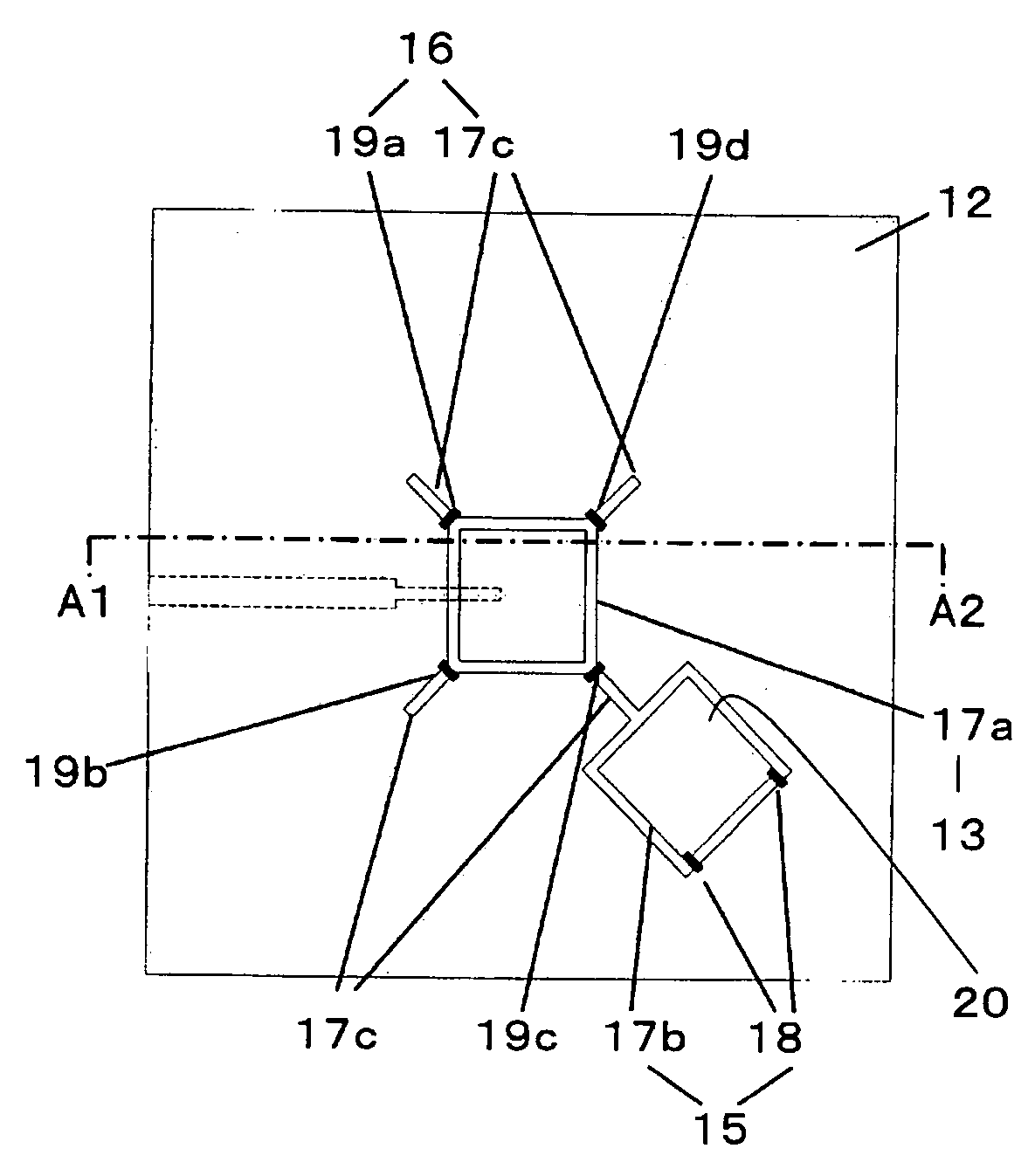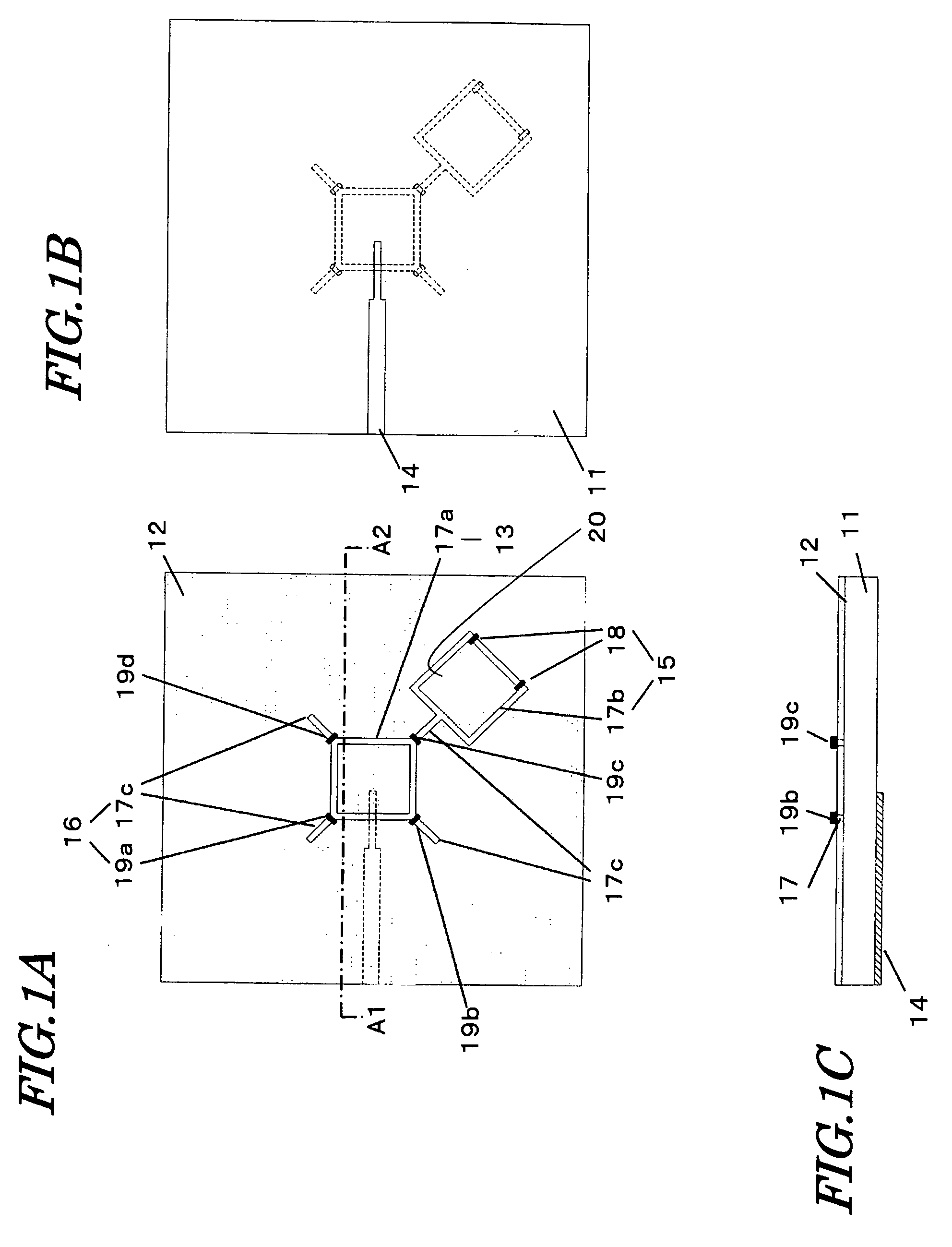Polarization switching/variable directivity antenna
a variable directivity, polarization switching technology, applied in the direction of antennas, slot antennas, basic electric elements, etc., can solve the problems of generating a completely circularly polarized, elliptically polarized wave, deteriorating communication quality, etc., and achieve good axial ratio characteristics
- Summary
- Abstract
- Description
- Claims
- Application Information
AI Technical Summary
Benefits of technology
Problems solved by technology
Method used
Image
Examples
embodiment 1
[0066]First, FIGS. 1A to 1C, which illustrate Embodiment 1 of the present invention, will be referred to FIG. 1A is a see-through view of a first surface (hereinafter, “front face”) of a dielectric substrate 11. FIG. 1B is a see-through view of a second surface (hereinafter, “rear face”) of the dielectric substrate 11 which opposes the first surface. FIG. 1C is a cross-sectional view taken along line A1-A2 in FIG. 1A.
[0067]As shown in FIG. 1, the antenna of the present embodiment includes a ground conductor plate 12 on the front face of the dielectric substrate 11. A loop-shaped first slot 17a, a loop-shaped second slot 17b, and linear-shaped third slots 17c are provided in the ground conductor plate 12. The slot 17b has at least two directivity switching switches 18 provided thereon, and each slot 17c has at least one polarization switching switch (19a to 19d) provided thereon. A feed member 14 is provided on the rear face of the dielectric substrate 11. Switching of the maximum ga...
example 1
[0101]Hereinafter, Example 1 of the present invention will be described. The antenna of Example 1 has the construction shown in FIGS. 1A to 1C, and an enlarged view of the neighborhood of the first slot 17a is as shown in FIG. 3. The constituent elements of Example 1 are as shown in Table 3.
TABLE 3dielectricdielectric constant: 2.08substrate 11size: 130.0 × 130.0 × 3.2 mmfirst slot 17asquarelength L1 of one side: 25.0 mmslot width w1: 2.0 mmsecond slot 17bsquarelength L2 of one side: 22.0 mmslot width w2: 3.0 mmthird slot 17clength L3 of one side: 10.0 mmslot width w3: 4.0 mm
[0102]In this case, the Q0 of the radiation element 13 is calculated to be 5.55, with the circular polarization index being about 3.1. In Example 1, the directivity switching element is allowed to function as a director.
[0103]FIGS. 7A, 7B, and 7C are diagrams showing examples of how the directivity switching switches 18 and the polarization switching switches 19a to 19d may be controlled in order to change the m...
embodiment 2
[0111]Hereinafter, with reference to the drawings, a polarization switching / variable directivity antenna according to Embodiment 2 of the present invention will be described.
[0112]FIG. 10 is a see-through view of a first substrate surface (front face) according to Embodiment 2 of the present invention. Portions which are drawn by broken lines are meant to be formed on a second substrate surface (rear face). The detailed description of any portion that has an identical counterpart in Embodiment 1 will be omitted.
[0113]In the polarization switching / variable directivity antenna of Embodiment 2, every third slot 17c defining a polarization switching element 16 has a second slot (24a to 24d) of a directivity switching element 15 connected thereto, at an end that is not continuous with a first slot 17a. Moreover, a second polarization switching switch (26a to 26d) is connected at each position adjoining a second slot (24a to 24d), so as to bridge across the third slot 17c.
[0114]In Embodi...
PUM
 Login to View More
Login to View More Abstract
Description
Claims
Application Information
 Login to View More
Login to View More - R&D
- Intellectual Property
- Life Sciences
- Materials
- Tech Scout
- Unparalleled Data Quality
- Higher Quality Content
- 60% Fewer Hallucinations
Browse by: Latest US Patents, China's latest patents, Technical Efficacy Thesaurus, Application Domain, Technology Topic, Popular Technical Reports.
© 2025 PatSnap. All rights reserved.Legal|Privacy policy|Modern Slavery Act Transparency Statement|Sitemap|About US| Contact US: help@patsnap.com



